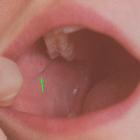buccinator muscle

A picture
from Gray"s anatomy that has been adjusted by User:Havaska to highlight the buccinator muscle.

An anatomical
illustration from the 1909 American edition of Sobotta"s Atlas and Text-book of Human Anatomy with English terminology
The buccinator muscle is a muscle of facial expression located in the cheek, between the maxilla and mandible, and functions chiefly as a muscle of mastication.
Summary
- origin: outer surface of alveolar process of both maxilla and mandible, and anterior margin of the pterygomandibular raphe
- insertion: converges on the modiolus of the mouth, where some fibers decussate to interdigitate with the contralateral muscle
- arterial supply: branches from the facial artery, buccal branch from the maxillary artery
- innervation: buccal branch of the facial nerve
- action: directs a food bolus onto the teeth, tenses the cheek and helps to close the mouth
Gross anatomy
The anterior border of the pterygomandibular raphe gives origin to the fibers that decussate at the modiolus of the mouth. Fibers arising from the maxilla and mandible, do not decussate and insert into the upper and lower lips respectively.
Buccinator is pierced by the parotid duct on its lateral aspect, opposite the upper third molar tooth .
Development
The buccinator muscle is categorically a muscle of facial expression as it is derived from the 2nd pharyngeal arch, and thus innervated by the facial nerve. Despite this, its primary function is assisting with mastication .
Siehe auch:

 Assoziationen und Differentialdiagnosen zu Musculus buccinator:
Assoziationen und Differentialdiagnosen zu Musculus buccinator:


